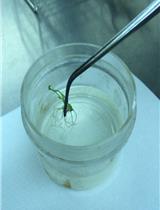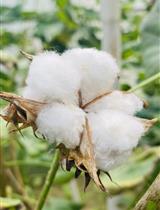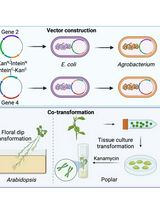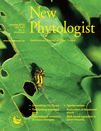- Submit a Protocol
- Receive Our Alerts
- Log in
- /
- Sign up
- My Bio Page
- Edit My Profile
- Change Password
- Log Out
- EN
- EN - English
- CN - 中文
- Protocols
- Articles and Issues
- For Authors
- About
- Become a Reviewer
- EN - English
- CN - 中文
- Home
- Protocols
- Articles and Issues
- For Authors
- About
- Become a Reviewer
Agrobacterium-mediated Transformation of Strawberry
Published: Vol 4, Iss 1, Jan 5, 2014 DOI: 10.21769/BioProtoc.1022 Views: 13998
Reviewed by: Tie Liu

Protocol Collections
Comprehensive collections of detailed, peer-reviewed protocols focusing on specific topics
Related protocols

Agrobacterium-mediated Transformation of Japonica Rice Using Mature Embryos and Regenerated Transgenic Plants
Ammar Elakhdar [...] Takahiko Kubo
Sep 20, 2021 6135 Views

Agrobacterium-mediated Genetic Transformation of Cotton and Regeneration via Somatic Embryogenesis
Alka Srivastava [...] Praveen C. Verma
May 20, 2023 4216 Views

A Novel Gene Stacking Method in Plant Transformation Utilizing Split Selectable Markers
Guoliang Yuan [...] Xiaohan Yang
Feb 20, 2025 1916 Views
Abstract
Traditional breeding for improvement of strawberry (Fragaria x ananassa) is difficult because strawberry is an octoploid, hybrid species. Genetic modification of strawberry would though be a promising alternative for obtaining the desired improvements in existing elite strawberry cultivars (Schaart et al., 2011). The availability of suitable genes for trait improvements in strawberry has however been a rate-limiting step until recently, but with the completion of the sequencing of the genome of woodland strawberry (F. vesca) (Shualev et al., 2011), we now have access to a treasure chest with valuable candidate genes. For strawberry, methods for genetic transformation have originally been described by Nehra et al. (1990) and James et al. (1990) and success of transformation was shown to be highly cultivar dependent. The latest progress in strawberry transformation is reviewed by Husaini et al. (2011). In our lab transformation of strawberry is based on the method for shoot regeneration described by Passey et al. (2003) and the use of the supervirulent Agrobacterium strain AGL0 (Lazo et al., 1991). We mainly make use of the strawberry transformation as a tool for functional analysis of candidate genes. For this the cultivar Calypso is a very suitable genotype because of its high transformation efficiencies (up to 100%) and ever-bearing fruiting characteristic, which provides a continuous supply of strawberry fruits once the plants start flowering.
Keywords: StrawberryMaterials and Reagents
- Sucrose (Duchefa Biochemie BV, catalog number: S0809 )
- Daishin agar (Duchefa Biochemie BV, catalog number: D1004 )
- 6-Benzylaminopurine (BAP) (Duchefa Biochemie BV, catalog number: B0904 ) Indole-3-butyric acid (IBA) (Duchefa Biochemie BV, catalog number: I0902 )
- Murashige and Skoog salts including vitamins (MS) (Duchefa Biochemie BV, catalog number: M0221 )
- Gelrite (Duchefa Biochemie BV, catalog number: G1101 )
- 3’,5’Dimethoxy-4’-hydroxy-acetophenone (Acetosyringone) (Sigma-Aldrich, catalog number: D134406 )
- LB broth (LB) (Sigma-Aldrich, catalog number: L3022 )
- Rifampicin (Duchefa Biochemie BV, catalog number: R0146 )
- Dimethyl sulfoxide (DMSO) (Merck KGaA, catalog number: 802912 )
- MN615 filter paper 82 mm (MACHEREY-NAGEL GmbH & Co. KG, catalog number: MN615)
- Thidiazuron (TDZ) (Duchefa Biochemie BV, catalog number: T0916 )
- 1-Naphthalene acetic acid (NAA) (Duchefa Biochemie BV, catalog number: N0903 )
- Cefotaxime sodium salt (cefotaxime) (Duchefa Biochemie BV, catalog number: C0111 )
- Kanamycin monosulphate monohydrate (kanamycin) (Duchefa Biochemie BV, catalog number: K0126 )
- D-glucose monohydrate (glucose) (Duchefa Biochemie BV, catalog number: G0802 )
- Shoot multiplication medium (SMM) (see Recipes)
- Shoot propagation medium (SPM) (see Recipes)
- Shoot regeneration medium (SRM) (gluc.) (see Recipes)
- SRM + AS (see Recipes)
- SRM SEL (see Recipes)
- MS-liquid + AS (see Recipes)
- 1 mg/ml NAA (see Recipes)
- 0.22 mg/ml TDZ (see Recipes)
- 1 mg/ml IBA (see Recipes)
- 1 mg/ml BAP (see Recipes)
- 100 mM AS (see Recipes)
- 125 mM Cefotaxime (see Recipes)
- 50 mg/ml Kanamycin (see Recipes)
- 50 mg/ml Rifampicin (see Recipes)
- 30 g/100 ml Glucose (see Recipes)
Equipment
- 50 ml tube (Greiner Bio-One GmbH, catalog number: 210261 )
- Petri dish (Greiner Bio-One GmbH, catalog number: 633180 )
- Rotary shaker (C24 incubator shaker, New Brunswick Scientific)
- Centrifuge Multifuge 3LR (Heraeus Holding)
Procedure
- For transformation of strawberry we made use of ‘in vitro’ grown plants. These plants were alternated cultured under sterile conditions on shoot propagation medium (SPM), which is Murashige and Skoog macro and micro elements and vitamins (Murashige and Skoog, 1962) (MS) (2.2 g/L), sucrose (30 g/L) Daishin agar (9 g/L), supplemented with BAP and IBA both at concentrations of 0.1 mg/L (pH 5.8) and shoot multiplication medium (SMM) which is MS (2.2 g/L), sucrose (30 g/L) Daishin agar (9 g/L), supplemented with BAP at concentration of 0.5 mg/L (pH 5.8).
- The plants were subcultured every 4-6 weeks by transferring side-shoots to fresh SPM and were grown in the light (16 h/8 h light/dark) in a culture room at 25 °C.
- Transformations were performed under sterile conditions in a biological safety down flow cabinet. For the transformation leaf discs of 7 mm in diameter were cut from ‘in vitro’ leaf material grown for four weeks on SPM. Leaf discs were collected in pertidishes containing cocultivation medium which is SRM+AS [SRM; MS (2.2 mg/L) with glucose (30 g/L), NAA (0.2 mg/L), TDZ (1.0 mg/L) and gelrite (4 g/L) (pH 5.8) supplemented with acetosyringone (100 μM)].
- The Agrobacterium strain AGL0, which contains the supervirulent Ti plasmid pTIBo542 (Lazo et al., 1991) as well as a binary vector harbouring a kanamycin resistance gene (nptII) as plant selectable marker, was cultured overnight in 50 ml tubes containing 10 ml liquid LB medium supplemented with kanamycin (50 mg/L) and rifampicin (50 mg/L). The bacteria were incubated in a rotary shaker at a temperature of 28 °C.
- After overnight growth, the bacteria were pelleted by centrifugation at 2,000 x g (3,000 rpm) for 10 min and the bacterium pellet was resuspended in 40 ml of filter-sterilized liquid MS-medium containing glucose (30 g/L) and acetosyringone (100 μM) (pH 5.2).
- For transfection 20 ml of resuspended Agrobacterium was poured on the leaf discs which were cut and collected before in a petri dish containing cocultivation medium.
- After 10-20 min the leaf discs were blotted dry on a sheet of filter paper and were subsequently placed on fresh cocultivation medium that was covered by a disc of MN615 filter paper. The leaf discs were placed with the adaxial side in contact with the filter paper (so, upside-down) and cocultivated with the Agrobacterium cells under sterile conditions, for four days at 21 °C in the dark.
- After cocultivation the leaf discs were transferred to SRM supplemented with cefotaxim (250 mg/L) for the elimination of Agrobacteria and kanamycin (100-150 mg/L) for the selective regeneration of shoots. In case overgrowth of the leaf discs with Agrobacteria is experienced, the leaf discs may be wash in a solution containing 500 mg/L cefotaxime prior to transfer to SRM. The leaf discs were cultured in a growth room at 21 °C and at 16 h/8 h light/dark conditions.
- The SRM medium was refreshed every 4 weeks and shoots that regenerated on the leaf discs were harvested and transferred to jars containing shoot propagation medium (SPM) with kanamycin (50 mg/L) and cefotaxime (250 mg/L) for further selection and propagation under sterile conditions, at 24 °C and at 16h/8h light/dark conditions. In a typical transformation experiment 50-100% of the leaf discs give transgenic shoots.
- Shoots that propagated well and produced roots on this medium were transferred to the same medium but now without kanamycin and cefotaxime to show absence of Agrobacterium and after sufficient roots were formed, the plants were transferred to the greenhouse for further evaluation.
Recipes
Note: All media containing antibiotics or IBA (which is light-sensitive), should be prepared freshly. All other media may be stored for a maximum of 14 days.
- Media for Propagation of Strawberry
- Shoot Multiplication Medium (SMM)
for 1,000 mlpH = 5.8MS
4.4 g
Sucrose
30 g
Agar Daishin
9 g
BAP
0,5 ml BAP-stock (1mg/ml), final concentration 0.5 mg/L
Autoclave (hormones are coautoclaved)
- Shoot Propagation Medium (SPM)
for 1,000 mlBAP 0,1 ml BAP-stock (1mg/ml), final concentration 0.1mg/L)MS
4.4 g
Sucrose
30 g
Agar Daishin
9 g
IBA 0,1 ml IBA-stock (1mg/ml), final concentration 0.1mg/L)
pH= 5.8
Autoclave (hormones are co-autoclaved)
Plants are cultured in alternating cycles on SMM for 4-6 weeks and then on SPM for 4-6 weeks. For transformation, leaves of plants which are grown for 4 weeks on SPM medium are used.
- Shoot Multiplication Medium (SMM)
- Media for strawberry transformation
- Shoot Regeneratoon Medium (SRM) (1,000 ml)
Dissolve:
4.4 g MS
4 g gelrite
into 900 ml MilliQ water
add:
0.2 ml NAA-stock (1 mg/ml) (final conc. = 0.2 mg/L)
4.5 ml TDZ-stock (0.22 mg/ml) (final conc. = 1 mg/L)
adjust pH to 5.8 with 0.1 N KOH
after autoclaving add 100 ml filter sterilised glucose-stock (30 g/100 ml)
- For SRM + AS (1,000 ml)
Add to SRM (after autoclaving)
1,000 μl acetosyringone-stock (100 mM) (final concentration 100 μM)
- For SRM SEL (1,000 ml)
Add to SRM (after autoclaving)
1,000 μl kanamycin-stock (50 mg/ml) (final concentration 100 mg/L)
2,000 μl cefotaxime-stock (125 mg/ml) (final concentration 250 mg/L)
- MS-liquid + AS (1,000 ml)
Dissolve:
4.4 g MS-salts+vit.
30 g Glucose
into 1,000 ml MilliQ
add:
1,000 μl AS-stock (100 mM)
adjust pH to 5.2 (!) with 0.1 N KOH
filter-sterilise and store at 4 °C in 50 ml tubes
- Shoot Regeneratoon Medium (SRM) (1,000 ml)
- Stock solutions
- NAA (1 mg/ml)
Dissolve 50 mg NAA in 1 ml 0.1 N KOH and adjust volume to 50 ml with MilliQ; stored at 4 °C
- TDZ (0.22 mg/ml)
Dissolve 55 mg TDZ in 1 ml 0.1 N KOH and adjust volume to 250 ml with MilliQ; stored at 4 °C
- IBA (1 mg/ml)
Dissolve 50 mg IBA in 1 ml 0.1 N KOH and adjust volume to 50 ml with MilliQ; stored at 4 °C
- BAP (1 mg/ml)
Dissolve 50 mg BAP in 1 ml 0.1 N KOH and adjust volume to 50 ml with MilliQ; stored at 4 °C
- AS (100 mM)
Dissolve 98 mg Acetosyringone in 300 μl DMSO and adjust volume to 5 ml with Ethanol absolute; stored at 4 °C
- Cefotaxime (125 mg/ml)
Dissolve 1,000 mg Cefotaxim in 8 ml MilliQ; filter sterilise; stored at 4 °C
- Kanamycin (50 mg/ml)
Dissolve 400 mg Kanamycin in 8 ml MilliQ; filter sterilise; stored at 4 °C
- Rifampicin (50 mg/ml)
Dissolve 400 mg Rifampicin in 100 μl 0.1N HCl and adjust volume to 8 ml with MilliQ; filter sterilise; stored at -20 °C
- Glucose (30 g/100 ml)
Dissolve 300 g Glucose in 1,000 ml MilliQ; filter sterilise; store at room temperature in 50 ml tubes
- NAA (1 mg/ml)
Acknowledgments
This protocol was adapted from the method for shoot regeneration described by Passey et al. (2003) and the use of the supervirulent Agrobacterium strain AGL0 (Lazo et al., 1991).
References
- Husaini, A.M., Mercado J.A., Teixeira da Silva J.A., Schaart J.G. (2011). Review of factors affecting organogenesis, somatic embryogenesis and Agrobacterium tumefaciens-mediated transformation of strawberry. In: Husaini AM, Mercado JA (Eds), Genomics, Transgenics, Molecular Breeding and Biotechnology of Strawberry. Genes, Genomes and Genomics 5 (Special Issue 1), Global Science Books Ltd., Isleworth, United Kingdom: 1-11
- James, D.J., Passey, A.J., Barbara, D.J. (1990). Agrobacterium-mediated transformation of the cultivated strawberry (Fragaria x ananassa Duch.) using disarmed binary vectors. Plant Sci 69, 79-94.
- Lazo, G. R., Stein, P. A. and Ludwig, R. A. (1991). A DNA transformation-competent Arabidopsis genomic library in Agrobacterium. Biotechnology (N Y) 9(10): 963-967.
- Murashige, T. and Skoog, F. (1962). A revised medium for rapid growth and bio assays with tobacco tissue cultures. Physiologia Plantarum 15(3): 473-497.
- Nehra, N. S., Chibbar, R. N., Kartha, K. K., Datla, R. S., Crosby, W. L. and Stushnoff, C. (1990). Genetic transformation of strawberry by Agrobacterium tumefaciens using a leaf disk regeneration system. Plant Cell Rep 9(6): 293-298.
- Passey, A. J., Barrett, K. J. and James, D. J. (2003). Adventitious shoot regeneration from seven commercial strawberry cultivars (Fragaria x ananassa Duch.) using a range of explant types. Plant Cell Rep 21(5): 397-401.
- Schaart, J. G., Kjellsen, T. D., Heggem, R., Iversen, T. H, Schouten, H. J. and Krens, F. A. (2011). Towards the production of genetically modified strawberries which are acceptable to consumers. In: Husaini AM, Mercado JA (Eds) Genomics, Transgenics, Molecular Breeding and Biotechnology of Strawberry. Genes, Genomes and Genomics 5 (Special Issue 1), Global Science Books Ltd., Isleworth, United Kingdom: 102-107.
- Shulaev, V., Sargent, D. J., Crowhurst, R. N., et al. (2011). The genome of woodland strawberry (Fragaria vesca). Nat Genet 43(2): 109-116.
Article Information
Copyright
© 2014 The Authors; exclusive licensee Bio-protocol LLC.
How to cite
Schaart, J. G. (2014). Agrobacterium-mediated Transformation of Strawberry. Bio-protocol 4(1): e1022. DOI: 10.21769/BioProtoc.1022.
Category
Plant Science > Plant transformation > Agrobacterium
Molecular Biology > DNA > Transformation
Do you have any questions about this protocol?
Post your question to gather feedback from the community. We will also invite the authors of this article to respond.
Share
Bluesky
X
Copy link








